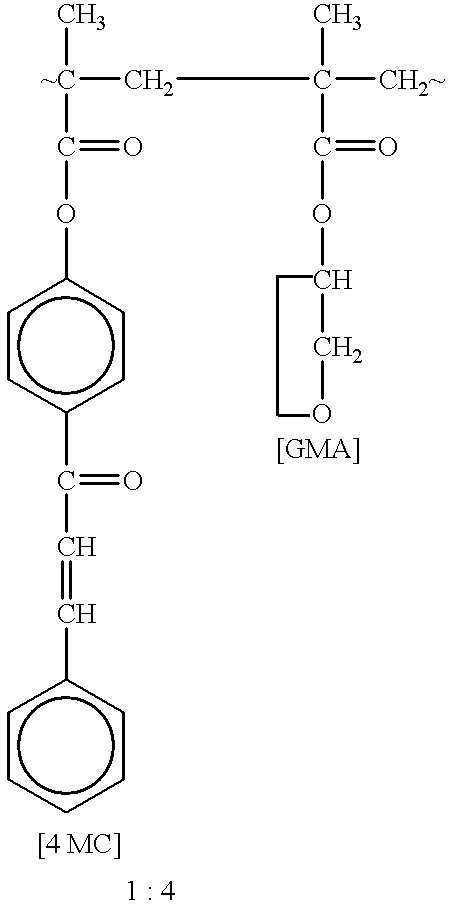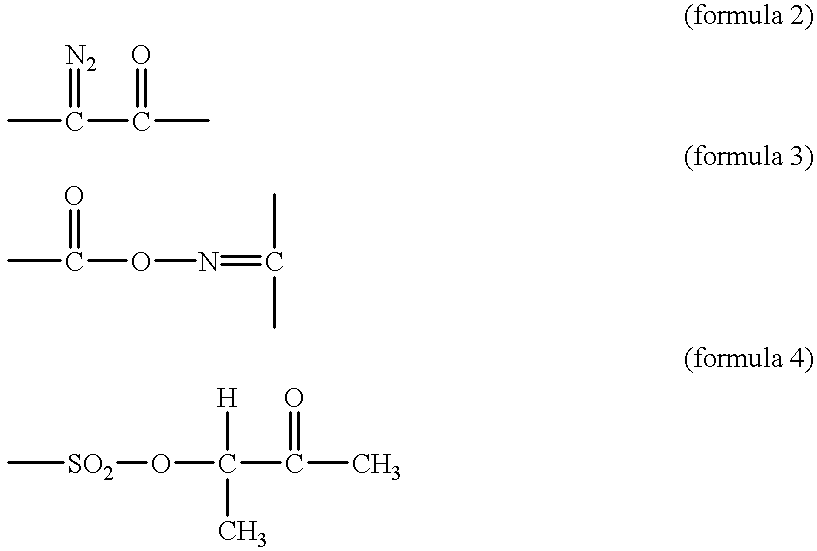Liquid crystal alignment film, method of manufacturing the film, liquid crystal display using the film and method, and method of manufacturing the liquid crystal display
a technology of liquid crystal alignment and alignment film, which is applied in the direction of thin material processing, material nanotechnology, instruments, etc., can solve the problems of poor uniformity of alignment film in surface step portions and display defects
- Summary
- Abstract
- Description
- Claims
- Application Information
AI Technical Summary
Benefits of technology
Problems solved by technology
Method used
Image
Examples
example 1-2
The same experiment as Example 1 was performed, except that CH.sub.3 (CH.sub.2).sub.14 SiCl.sub.3 and NC(CH.sub.2).sub.14 SiCl.sub.3, which contain a linear hydrocarbon group comprising one functional group for controlling the surface energy of a film at the terminal and Si, were used as the silane-based surfactant after the exposure of the entire face (they were mixed at a mole ratio of 1:1).
As a result of the reaction with the chlorosilane-based surfactant, a monomolecular chemisorption film was formed selectively in the portion on the surface of the substrate where hydroxyl groups have been generated by exposure. This monomolecular film was chemically bonded thereto via siloxane bonds in a thickness of about 1.5 nm. The critical surface energy of the chemisorption film was about 27 mN / m.
Furthermore, two substrates in this state were used so as to be set so that the chemisorption films were facing each other. Thus, a liquid crystal cell having a 20 micron gap was assembled so that...
example 2
First, a positive resist 22 (e.g., AZ1400 manufactured by SIHPLEY) mainly composed of a novolak resin and comprising a naphthoquinone diazido based photosensitizer containing the group represented by (formula 2) was applied onto a surface of a glass substrate 21 provided with TFT always having pixel electrodes on their surfaces to a thickness of 0.1 to 0.2 .mu.m and dried so as to form a film. The critical surface energy of the film was 28 mN / m. Next, using a photomask 23 for dividing each pixel (a polarizing plate or a diffraction grating may be disposed on the mask for dividing the pixel for the purpose of improving the alignment property of the adsorption film), the positive resist was exposed to light of 435 nm at 100 mJ / cm.sup.2 (FIG. 5). As a result, the resist reacted with moisture in the air in an exposed portion 22' so as to proceed the reaction represented by (formula 5). At this time, since --COOH group 25 generated by the exposure contains active hydrogen (FIG. 6, which ...
example 3
After exposure and before the process of chemisorption of the molecules comprising linear hydrocarbon groups in Example 1, the substrate was immersed in an adsorption solution prepared by dissolving a compound containing a plurality of chlorosilyl groups in a dry atmosphere. Then, a dehydrochlorination reaction was effected between hydroxyl groups of the carboxyl groups generated on the surface of the resist and chlorosilyl groups of the compounds containing a plurality of chlorosilyl groups. Thereafter, when a reaction with water was allowed to be effected, the remaining chlorosilyl groups changed to hydroxyl groups, so that a chemisorption film comprising a large number of hydroxyl groups on its surface was formed.
For example, SiCl.sub.4 was used as the silyl compound containing a plurality of chloro groups, and dissolved in Fluorinert FC40 (3M product name) so as to prepare an adsorption solution. Then, the exposed substrate was immersed in the adsorption solution. As a result, s...
PUM
 Login to View More
Login to View More Abstract
Description
Claims
Application Information
 Login to View More
Login to View More - R&D
- Intellectual Property
- Life Sciences
- Materials
- Tech Scout
- Unparalleled Data Quality
- Higher Quality Content
- 60% Fewer Hallucinations
Browse by: Latest US Patents, China's latest patents, Technical Efficacy Thesaurus, Application Domain, Technology Topic, Popular Technical Reports.
© 2025 PatSnap. All rights reserved.Legal|Privacy policy|Modern Slavery Act Transparency Statement|Sitemap|About US| Contact US: help@patsnap.com



